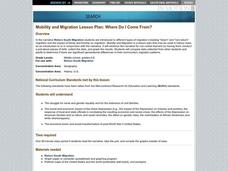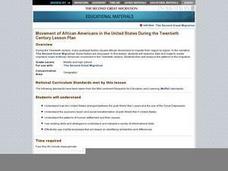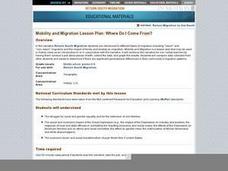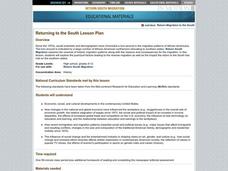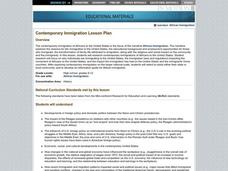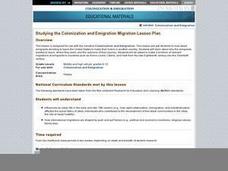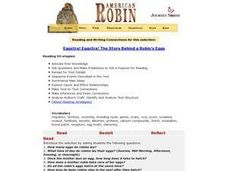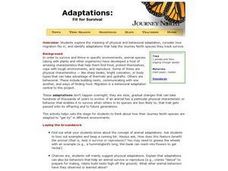Curated OER
Weather Conditions During the Fall Monarch Migration
Students keep detailed weather records during the fall migration of the monarch butterfly. They compare weather conditions to the days they do and do not see monarchs. As a class, they graph and analyze data and send it to a university...
Curated OER
Observing Fall Migrants
Pupils observe the migration of monarch butterflies. They collect data regarding the number of monarchs they see, the location, the butterflies' behavior, the temperature and the date and time. Then they send their data to a university...
Curated OER
Weather Conditions During the Fall Monarch Migration
Young scholars keep detailed weather records (temperature, wind direction, predipitation) during the fall migration of the monarch butterfly. They analyze their data and create a chart or graph depicting the data. Finally they relate the...
Curated OER
Weather Conditions During the Spring Monarch Migration
Middle schoolers keep detailed weather records during the spring migration of the monarch butterfly. To keep track of the weather, students utilyze weather reports and instuments such as anemometers, compasses, thermometers and rain gauges.
Curated OER
Heaven, Hell, and Baltimore
This lesson plan allows students to research and compare the city of Baltimore to other northern cities of interest during the Great Migration. After reading a narrative entitled Return South Migration and conducting extensive research,...
Curated OER
Migration Migraine
Young scholars partipate in a demonstration in which they role play animals migrating between breeding and wintering habitats and encountering hazards at each end of the journey.
Curated OER
Monarch Butterfly Migration Map
Students examine the migration patterns of the monarch butterfly. They practice using color-coded maps. They create their own maps based on the butterfly's migration. They share their maps wtih the class.
Curated OER
How Animals Prepare for Winter
Second graders study which animal hibernate and which migrate. They observe the weather conditions related to each and complete the associated worksheets and web activity.
Curated OER
Get Ready to Hibernate! Migrate! or Get Fat!
Young scholars explore the different ways which animals survive the winter months, and sort animals into correct categories using a Venn diagram.
Curated OER
Duck, Duck, GOOSE!
Students examine the migratory cycle of Canada geese, and explore the reasons that some birds have stopped migrating and become residents of an area. They identify the ways which geese are considered pests and explore ways to control...
Curated OER
Getting There: "Do You Want To Go To California?"
Students, in groups, participate in a variety of activities regarding the rise of Anglo-American immigration in the 1840s and its impact upon California. They discuss immigration from the West and the East as it influenced the culture of...
Curated OER
Travel Time
Students use a migration map to estimate the distance traveled by a bird while migrating south. After calculating accurate estimates of the distance traveled, students compare the distances traveled with the amount of time elapsed.
Curated OER
Home Ties
Students explore the reasons people choose to migrate including political, economic and familial motivations. They interview family members and compare their ancestors own reasons for migration to those of African American urban migrants.
Curated OER
WHERE DO I COME FROM?
Students analyze the struggle for racial and gender equality and for the extension of civil liberties, the social and economic impact of the Great Depression, and the economic boom and social transformation of post-World War II United...
Curated OER
Movement of African Americans in the United States During the Twentieth Century
Students examine data and maps to create migration maps of African-American movement in the Twentieth century. They analyze the patterns in the migration.
Curated OER
Mobility and Migration: Where Do I Come From?
Students investigate the different types of migration that took place during the Great Depression. They compare data to determine if there are significant generational differences in migration patterns.
Curated OER
Returning to the South
Students write feelings about the concept of Home. They discuss reasons for leaving home. They read "Return South Migration" and in groups interview each other about the narrative. They complete a worksheet and write an editorial for the...
Curated OER
Contemporary Immigration Lesson Plan
Students research contemporary immigrations of Africans to the United States. They study their community's immigration facts, and develop an information guide for African immigrants.
Curated OER
Studying the Colonization and Emigration Migration
Students read and discuss a narrative about emigration. They examine the reasons why emigrants leave their home land, where they went and the result of their journey. They create a timeline of related migrations of emigrants to other...
Curated OER
American Robin: Eggstra! Eggstra! The Story Behind a Robin's Eggs
Pupils answer questions about robin's eggs. They read about robins, then mark up text for unfamiliar words.
Curated OER
Bird Populations
Students gather data about bird populations. They study bird migratory patterns using the methods that researchers use. They write an essay explaining the differences between the four types of population movements.
Curated OER
Parallel Studies of the Afro-American and Puerto Rican Experience in America
Students compare/contrast the Afro-American and Puerto Rican experience as they migrated and assimilated in the U.S. They research and discuss the reasons for migration and the historical significance of economic autonomy and oppression.
Curated OER
Adaptations: Fit For Survival
Middle schoolers track species using the Journey North project. They examine the meaning of physical and behavioral adaptation, migration, and identify adaptations that help the species they track survive.
Curated OER
Mapping Data Made Manageable
Students explore how to select unbiased random samples as they choose report data to include on maps. They propose methods for choosing random numbers and discuss their advantages and disadvantages. They consider bias in science.















